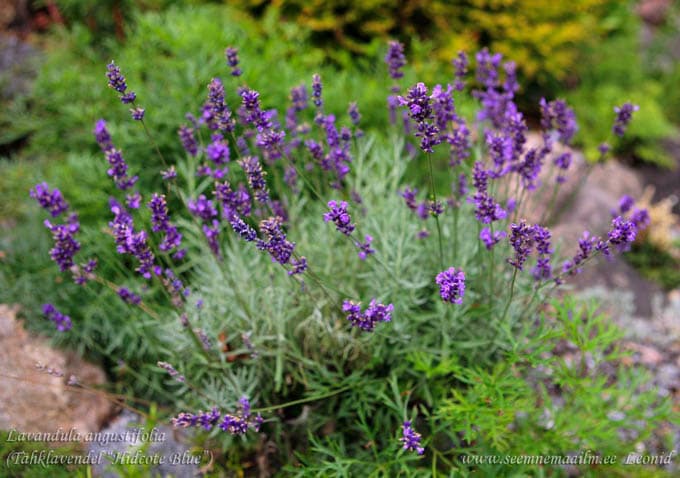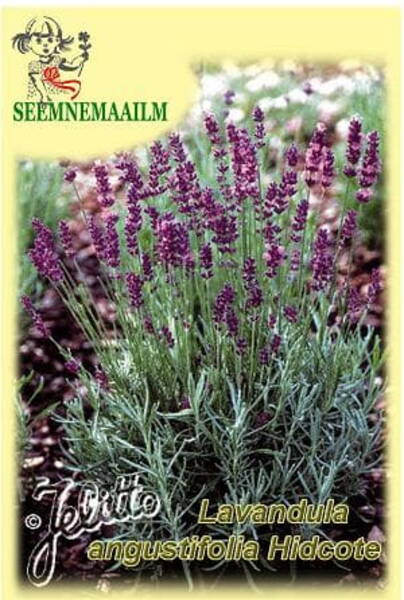Homeland: Southern Europe.
A perennial subshrub with a woody fibrous root reaching two meters in length and numerous shoots up to 60 cm high.
The leaves are opposite, dense, sessile, linear, silvery-greenish-gray, with delicate pubescence.
The flowers are small, bisexual, bluish-lilac or blue, collected in interrupted spike-shaped inflorescences of 6-10 flowers in whorls, which are located on the tops of leafless stems at intervals of 0.5-2 cm. Inflorescences are violet-blue to lilac, labiform The flowers smell pleasant and are collected in long spikes.
Blooms in July - August.
Winter-hardy plant (up to zones 4-5 with shelter).
Seeds can remain viable for many years when stored in hermetically sealed containers.
Hidcote lavender is one of the most common types of English lavender and is often used for low natural hedges. In addition, there are several varieties bred mainly in England, for example:
"Alba" - white inflorescences, 50 cm;
"Rosea" - lilac-pink inflorescences, 40 cm;
"Munstead" - deep blue inflorescences, 40 cm, compact, reliable shrubs;
"Hidcote Blue" - violet-blue, 40 cm, compact, reliable bushes;
"Hidcote Giant" - up to 60 cm tall, characterized by a compact bush shape.
In Estonia and further north it is better to grow lavender angustifolia, because other species are more thermophilic.
Location: grows well in a sunny, warm, even hot place.
Soil: dry, fresh, well-permeable, gravelly or sandy-clayey, moderately nutritious, contains lime (lavender cannot grow on heavy clay soils with high acidity and high groundwater levels). The soil mixture is prepared light and fertile - from leaf soil, humus, sand, taken in a ratio of 3:2:1, adding complete mineral fertilizer to it at the rate of 20 g per hole.
Planting: plants are planted at a distance of 30 - 40 cm from each other. Planting depth 25-30 cm.
Care: cut regularly in spring. In dry weather, water thoroughly. In the conditions of Estonia, it must be reliably covered for the winter (spruce branches and pine needles are suitable). If, however, the above-ground part is frozen, then it is cut off, and the plant, as a rule, is restored. The same pruning is used to regularly rejuvenate the bushes so that they do not become bare underneath.
It is important to never prune too much - to the point of woody stems, as the plant may die.
Reproduction: cuttings.
Can also be propagated by seeds. Seeds require stratification for 30-40 days at a temperature of +5 °C. 1,0 g = 1400 seeds.
Sow seedlings at the end of February - beginning of March to a depth of 3 mm. Seeds germinate in the light at a temperature of +15+21 °C. Treatment with gibberellin (100 - 200 mg/l) gives a stronger effect. When the seedlings grow, they are planted in 5 cm increments. In May, the seedlings are planted in a permanent place. You can sow seeds on the ridges in the fall, at the end of October. Shoots appear in the spring, at the end of May. For cuttings, lignified annual shoots are taken, cut into cuttings 8 - 10 cm long and rooted.
To propagate by dividing the bush in the fall, the plants are cut to a height of 8 - 10 cm and covered with earth, carefully filling the space between the stems. In the spring, soil is also added to the bushes. During the summer, lavender produces abundant growth that takes root well. In the fall, the bush is dug up and divided.
Another simple way to propagate lavender is by layering. To do this, in the spring, carefully bend 2-3 shoots and place them in a shallow (3-5 cm) groove, pin them down, cover them with soil and water them. During the summer, the ground here should be slightly moist. Usually next spring the shoot can already live independently and is cut off from the mother bush.
Application: on terraces, in gardens with fragrant herbs. Harvest lavender flowers as soon as they are fully open, when their color and scent will be most intense.
Flowers should be dried in a shaded and well-ventilated place.
Partners: bushes or subshrubs that love dry soils. Grows well with roses. Ideal partners for lavender are the diverse plants of fragrant gardens and many plants with yellow colored flowers (they perfectly set off the deep blue and purple colors of lavender).
For many years, different species and varieties of fragrant Santolina have been considered traditional partners.

Сommon lavender, English lavender, true lavender, lavender. Bot. syn.: Lavandula delphinensis Jord ex Billot, Lavandula officinalis Chaix., Lavandula spica L., Lavandula vera DC.












